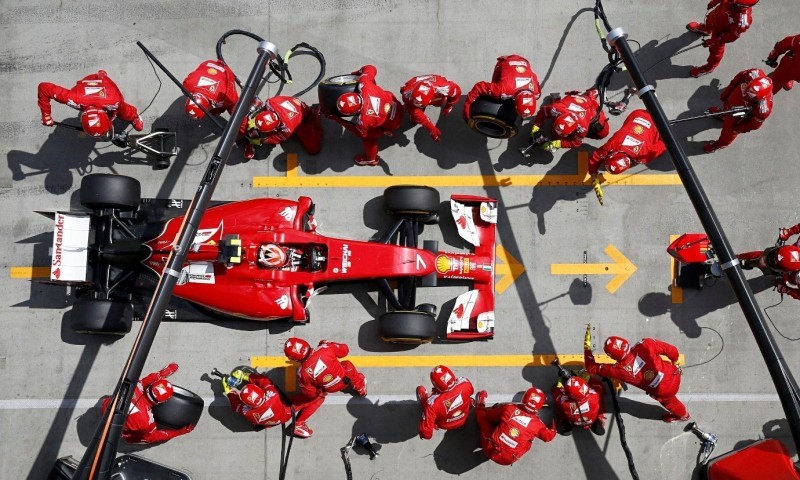Formula 1 Pit Stop Fire

This problem explores one of the possible disasters associated with an extremely short pit stop at extremely high speeds reaching up to during Formula 1 racing.
As a race car rolls along a pavement, electrons move from the pavement first onto the tires and then onto the car body. The car stores this excess charge and the associated electric potential energy as if the car body were one plate of a capacitor and the pavement were the other plate. When the car stops, it discharges its excess charge and energy through the tires, just as a capacitor can discharge through a resistor. If a conducting object comes within a few centimeters of the car before the car is discharged, the remaining energy can be suddenly transferred to a spark between the car and the object. This could prove to be an extremely dangerous situation especially for, say, a Formula 1 race car stopping at a pit stop, as it can stop for only a few seconds. Suppose the conducting material is a fuel dispenser. The spark will not ignite the fuel and cause a fire if the spark energy is less than a certain critical value, Let us model this situation.
When the Formula 1 race car stops at time for a quick pit stop, the car-ground potential difference is The car-ground capacitance is and the resistance of each tire is
How much time (in seconds) does the car take to discharge through the tires to drop below the critical value
The tire resistances can be assumed to be in parallel connection. Give your answer to 2 decimal places.
A Formula 1 car requires at least this much time before fuel can safely be brought near it. However, a pit crew cannot wait that long. So the tires include some type of conducting material (such as carbon black) to lower the tire resistance and thus increase the discharge rate. This drastically reduces the discharge time and thus the pit stop is completed successfully in a very short time.
The answer is 9.40.
This section requires Javascript.
You are seeing this because something didn't load right. We suggest you, (a) try
refreshing the page, (b) enabling javascript if it is disabled on your browser and,
finally, (c)
loading the
non-javascript version of this page
. We're sorry about the hassle.
Relevant wiki: RC Circuits (Direct Current)
This can be effectively modelled as an RC circuit with R e f f = R t i r e / 4 = 2 5 G Ω (because the 4 tires are in parallel.)
The scenario is that of a capacitor having charge q 0 = C V 0 = 1 5 ∗ 1 0 − 6 C and discharging through a resistor.
Now Energy U ( t ) = q ( t ) 2 / 2 C where q ( t ) = q 0 e − t / R C
Hence at U f i r e = q 0 2 e − 2 t / R C = C V 0 2 e − 2 t / R C / 2
Solving this equation for t we get,
t = − R C / 2 l n ( 2 U f i r e / C V 0 2 ) .
Plug and chug we get t = 9 . 4 s .
Obviously a pit crew cannot wait that long.